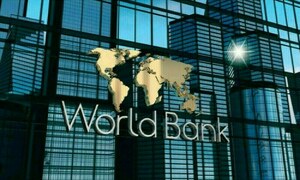World Bank Suggests Higher Taxes for Top Earners in Pakistan
The World Bank has advised Pakistan to implement higher effective tax rates for the highest-income groups. According to their recent report, titled “South Asia Development Update, Taxing Times,” Pakistan’s income tax system could become more progressive by eliminating exemptions for high-income earners and increasing the income threshold for the highest tax bracket.
The report also highlighted that industrial production has seen a contraction, primarily due to elevated input costs, increased taxes, and reduced government spending on development. The growth of services has been negatively impacted by the weak performance of the agricultural and industrial sectors.
Pakistan is identified among the Emerging Market and Developing Countries (EMDEs) with considerable disparities in tax rates and income thresholds across personal income tax brackets, which contributes to the relative progressivity of its income tax regime.
Commitment to Revenue Increase
The Pakistani government has pledged to boost tax revenues by an amount equivalent to 4–5% of GDP, reform the energy sector, and permit a flexible exchange rate, the report stated.
The World Bank suggests replacing subsidies that encourage inefficient use of resources, such as the guaranteed price for sugarcane and subsidized water consumption, with direct and targeted transfers. They also propose higher transfers for farmers who adopt sustainable land management practices.
Pakistan’s tax buoyancy is among the lowest quartile of EMDEs, indicating a heavy reliance on taxing slower-growing economic sectors. Consumption taxes (like sales tax, excise taxes, and VAT) and trade taxes account for a larger share of tax revenues in all South Asian countries except Bhutan and Pakistan, compared to the average EMDE, with income taxes contributing a smaller share. In 2024, consumption tax rates in Pakistan and Sri Lanka were significantly higher than the EMDE average.
The report further indicated that Pakistan, Sri Lanka, and Bangladesh—the South Asian nations with the lowest overall revenue-to-GDP ratios—also exhibit much lower tax revenue-to-GDP ratios compared to other EMDEs with similar tax rates across all tax categories.
Since 2020, Afghanistan, Bangladesh, Pakistan, and Sri Lanka have experienced significant shortfalls in direct tax revenue, ranging from 1.4 to 2.6 percentage points of GDP, compared to an average shortfall of 0.8 percentage point among all EMDEs. These revenue shortfalls have been almost evenly divided between personal and corporate income tax revenues in these four South Asian nations.
Among the four countries—Bangladesh, Bhutan, Pakistan, and Sri Lanka—with above-average tax revenue shortfalls, country-specific characteristics account for a quarter of the overall shortfalls in Bangladesh and Bhutan, and a third in Pakistan and Sri Lanka. Widespread informality and a lack of financial development contribute to one-half, one-third, and one-quarter of the personal income tax revenue shortfall in Bhutan, Pakistan, and Sri Lanka, respectively.
A large agricultural sector and underdeveloped financial systems account for half of the corporate income tax revenue shortfall in Bangladesh, Pakistan, and Sri Lanka, and a third of the consumption tax revenue shortfall in Pakistan and Sri Lanka. Even after accounting for these factors, these four countries still have larger tax gaps than the EMDE average.
The evaluation for Pakistan identifies areas needing improvement, including compliance risk management, the timeliness of tax declaration filings, tax dispute resolutions, tax payments, and the monitoring of inaccurate reporting.
In Pakistan, the implementation of electronic VAT filing and computerized risk analysis has halved refund claims and significantly improved the detection of fraudulent claims compared to manual assessments.
The responsiveness of revenues to changes in tax bases in Bangladesh and India is comparable to other emerging market and developing economies (EMDEs). Nepal’s responsiveness is among the top quartile of EMDEs, while Pakistan’s is in the bottom quartile.
Tax buoyancies in Bangladesh and India are generally in line with other EMDEs, while Nepal’s ranks in the top quartile and Pakistan’s in the bottom quartile.
Below-average tax buoyancies, as seen in Pakistan, suggest that economic growth is disproportionately driven by under-taxed activities. In Pakistan, the agricultural sector contributed approximately one-fifth of cumulative growth between 2010 and 2019, compared to less than one-tenth in the average EMDE. The agricultural sector in many parts of Pakistan faces considerably lower income tax rates than non-agricultural sectors. Therefore, increasing taxation of agricultural activity is a priority for raising tax revenues.
The report also indicated that Pakistan’s economy is recovering from natural disasters, external pressures, and inflation, with an expected growth of 2.7% in fiscal year 2024-25 and 3.1% in fiscal year 2025-26.
Pakistan’s GDP grew by 2.5% in fiscal year 2023-24, following a slight contraction in fiscal year 2022-23. Strong remittance inflows supported private consumption, but private investment growth remained weak due to high real interest rates and political instability. Favorable weather conditions led to a 19-year high in agricultural growth, while industrial activity contracted and services growth remained subdued. This weak growth has continued into the first half of fiscal year 2024-25, with output increasing by an average of 1.5% year-over-year, slower than the 2.1% expansion in the first half of the previous year.
After a surge last year, agriculture posted subdued growth in the first half of fiscal year 2024-25 amid drought-like conditions and pest infestations.
The government achieved a primary surplus in the first half of fiscal year 2024-25, with fiscal consolidation efforts supported by an IMF program. The current account was in surplus at the end of 2024, driven by higher remittances resulting from reduced political uncertainty and exchange rate stability, which more than offset the wider trade and primary income deficits.
As depreciation pressures on the currency eased, a strong agricultural harvest and stabilizing administrative prices helped inflation decline steadily to 0.7% in March 2025 from nearly 40% in mid-2023. Consequently, the central bank has lowered its policy rate by 10 percentage points since June 2024, reaching 12% in January.



Comments (0)
No comments yet. Be the first to comment!
Leave a Comment